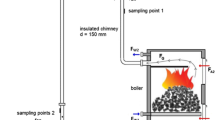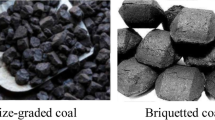Abstract
Solid fuels combustion is rather complicated because there is always environment pollution by emissions, mainly by particulate matter. The efforts of heat sources manufacturers and also operators should be increase the effectivity of the combustion process with minimizing of emissions production. Nowadays it is possible effectively burn the biomass fuels in modern heat sources. The combustion process of biomass is influenced by many aspects. This work deals about these aspect that influence the combustion efficiency and emissions production of small heat source. Automatic small hot-water boiler for wood pellets with 18 kW heat power was used for the experiments. The effect of the amount, temperature and relative humidity of combustion air, fuel moisture and fuel feeding on heat power and production of carbon monoxide and nitrogen oxides has been determined. The experiments results show that these tested aspects have high impact on combustion process and environment pollution. The most significant aspect was fuel moisture while wit rising moisture the heat power of boiler significantly decreased and production of emissions increased.









Similar content being viewed by others
References
Taušová M, Mihaliková E, Čulková K, Stehlíková B, Tauš P, Kudelas D, Štrba L (2019) Recycling of communal waste: current state and future potential for sustainable development in the EU, Sustainability (Switzerland), 11/10, https://doi.org/10.3390/su11102904
Vitázek I, Klúčik J, Uhrinová D, Mikulová Z, Mojžiš M (2016) Thermodynamics of combustion gases from biogas. Res Agric Eng 62:S8–S13
Pilat P, Patsch M (2018) Simulation of combustion air flow in the gasification biomass boiler. MATEC Web Conf 168:02015. https://doi.org/10.1051/matecconf/201816802015
Chabadova J, Papucik S, Nosek R (2014) Particle emissions from biomass combustion. AIP Conf Proc 1608:67–70. https://doi.org/10.1063/1.4892709
Dzurenda L, Banski A (2015) Dependence of the boiler flue gas losses on humidity of woody biomass. Arch Thermodynamics 36(4):77–86. https://doi.org/10.1515/aoter-2015-0034
Zagorecki K, Ristvej J, Klupa K (2015) Analytics for protecting critical infrastructure. Commun Sci Lett Univ Zilina 17(1):111–115
Buczynski R, Weber R, Szlek A, Nosek R (2012) Time-dependent combustion of solid fuels in a fixed-bed: measurements and mathematical modeling. Energy Fuel 26(1):4767–4774. https://doi.org/10.1021/ef300676r
Mikulova Z, Vitazek I (2016) Proportion of volatile matter in selected biofuels, 23rd International PhD Students Conference (MendelNet), 892-897
Lacinák M, Ristvej J (2017) Smart City, Safety and Security. Procedia Eng 192:522–527. https://doi.org/10.1016/j.proeng.2017.06.090
Dzurenda L, Ladomersky J, Hroncova E (2015) Conversion factor of fuel-bound nitrogen to oxides in the process of spruce wood combustion in boiler grate furnaces. Pol J Environ Stud 24(2):505–509. https://doi.org/10.15244/pjoes/27408
Krpec K, Horak J, Laciok V, Hopan F, Kubesa P, Lamberg H, Jokiniemi J, Tomsejova S (2016) Impact of boiler type, heat output, and combusted fuel on emission factors for gaseous and particulate pollutants. Energy Fuel 30(10):8448–8456. https://doi.org/10.1021/acs.energyfuels.6b00850
STN EN 14961–2, 2011: Solid biofuels. Fuel specifications and classes. Part 2:Wood pellets for non-industrial use
STN EN 14774, 2010: Solid biofuels. Determination of moisture content. Oven dry method
STN EN ISO 18122, 2015: Solid biofuels. Determination of ash content
STN EN 15210, 2010: Solid biofuels. Determination of mechanical durability of pellets and briquettes
STN EN 14918, 2010: Solid biofuels. Determination of calorific value
STN EN 303–5: 2012: Heating boilers. Part 5: Heating boilers for solid fuels, manually and automatically stoked nominal heat output of up to 500 kW. Terminology, requirements, testing and marking
Dzurenda L, Banski A (2017) Influence of moisture content of combusted wood on the thermal efficiency of a boiler. Arch Thermodynamics 38(1):63–74. https://doi.org/10.1515/aoter-2017-0004
Horak J, Jankovska Z, Straka F, Buryan P, Kubesa P, Hopan F, Krpec K (2013) Problems of determination of characteristic temperatures of biomass ash fusibility (in Czech). Chem List 107(6):502–509
Werle S (2014) Impact of feedstock properties and operating conditions on sewage sludge gasification in a fixed bed gasifier. Waste Manag Res 32(10):954–960. https://doi.org/10.1177/0734242X14535654
Jandacka J, Holubcik M, Papucik S, Nosek R (2012) Combustion of pellets from wheat straw. Acta Montan Slovaca 17(4):283–289
Rimár M, Kulikov A (2016) NOx formation in combustion of gaseous fuel in ejection burner. AIP Conf Proc 1745:020051
Adamczyk W, Werle S, Ryfa A (2014) Application of the computational method for predicting NOx reduction within large scale coal-fired boiler. Appl Therm Eng 73:341–348
Acknowledgments
This work was created under the projects APVV 15-790 “Optimization of combustion of biomass with low temperature melting behavior of ash” and KEGA 033ŽU-4/2018 “The heat sources and pollution”.
Author information
Authors and Affiliations
Corresponding author
Additional information
Publisher’s note
Springer Nature remains neutral with regard to jurisdictional claims in published maps and institutional affiliations.
Rights and permissions
About this article
Cite this article
Jandačka, J., Holubčík, M. Emissions Production from Small Heat Sources Depending on Various Aspects. Mobile Netw Appl 25, 904–912 (2020). https://doi.org/10.1007/s11036-020-01519-1
Published:
Issue Date:
DOI: https://doi.org/10.1007/s11036-020-01519-1




